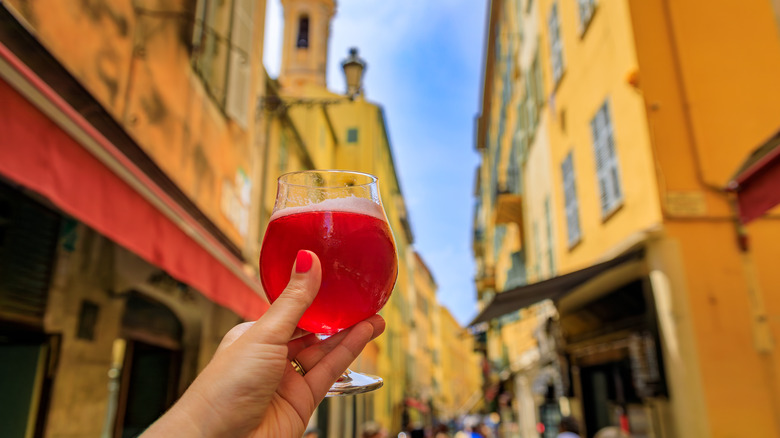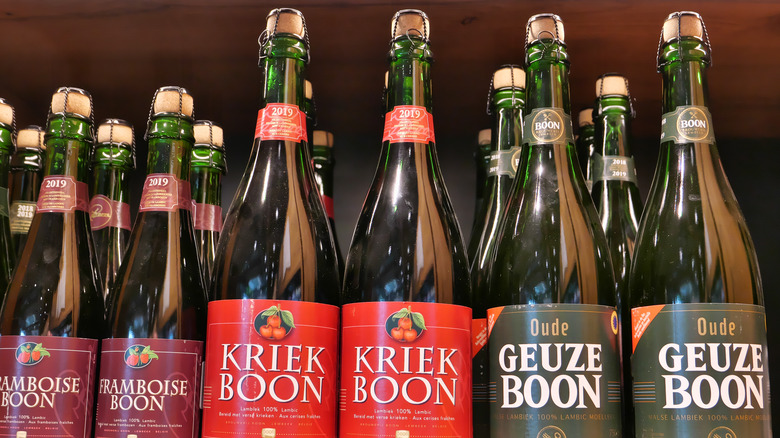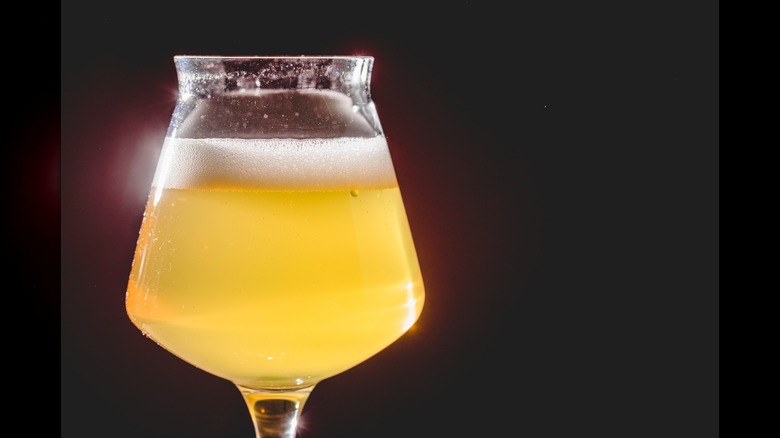The Oldest Style Of Beer In The World Is A Funky Favorite
If you're looking for a truly historic beer, you won't find it in a stout, lager, or pilsner. While these styles have been around for centuries and each have rich histories, they're young in comparison to lambics. This beer style dates back 8,000 years, where ancient Sumerians used a mix of malted barley, unmalted wheat, and spontaneous fermentation to make an alcoholic beverage.
Today, lambic beer is made in largely the same way (with the addition of hops), steeping the drink in tradition and a distinctive funky essence thanks to spontaneous fermentation and wild yeast. You can find lambic in young, aged, fruited, and un-fruited varieties. Gueuze, a blend of young and old lambics is intensely sour and can be fruity (if a fruited lambic was used in the mix). Fruited lambics can include kriek (cherry), framboise (raspberry), peche (peach), cassis (black currant), muscat (grape), and pomme (apple). These versions have strong fruit flavors and are often brightly-colored.
Some argue that a true lambic beer needs to come from Belgium, specifically the Pajottenland region, similar to how champagne needs to come from the Champagne region of France (unlike prosecco). However, lambic doesn't enjoy the same name protection laws that Champagne does. In 2016, American brewers established Méthode Traditionnelle to honor lambic beers when making them abroad, specifying they should be using processes true to Belgian traditions. You may see these referred to as Belgian-style, coolship, American spontaneous, or Northwest sour ales.
Lambic beers use distinctive brewing methods
The ingredients used to make lambics are much like other beers — hops, malt, wheat, yeast, and water — but with tweaks that make the end product distinctive. Instead of dried or fresh, lambic brewers use aged hops. Then, unlike the gentle mash and short boil time that other brews use, the malt and yeast in lambic beers are vigorously mashed, then boiled for at least a few hours. This process helps break the mash down into smaller sugars which can be readily fermented later.
At this point, most beers use specially-selected yeast strains to ferment the mash under controlled conditions, but not lambics. Spontaneous fermentation is used, where the wort (or beer mash that's been boiled and strained) is transferred to a large shallow vessel to cool it and expose it to the air, where wild yeast and bacteria float around and can make contact with it. The cooling process takes about 15 hours before the mix is added to a holding tank and then oak barrels for aging. Young lambics are aged six months to a year, while old ones are aged one to three years.
Lambic is not to be confused with sour, a general umbrella term that includes lambics, but can use spontaneous fermentation, acids, or bacteria to achieve a sour flavor profile. And while also a Belgian ale, saisons are not the same as lambics either, as this style uses a more controlled fermentation process with particular yeast strains.
Spontaneous fermentation gives lambic its funk
The wild yeast used to make lambic beer makes each batch unique, even unpredictable. However, you can expect lambics to have a balance of sour and funky notes. This funkiness is thanks to a wild yeast called Brettanomyces, which imparts a barnyard-like taste like horses, goats, leather, or wet hay. If that sounds odd and polarizing, that's because it is. While some enjoy the depth of this funkiness, it's not for everyone. In fact, if Brettanomyces sounds familiar, that's because it can sometimes be considered a wine flaw when it's not expected. This is one of the reasons waiters pour a sample of wine for you to taste before you get a whole bottle — you're looking for off tastes, grounds for sending the bottle back.
Lambics can also have subtle cheesy notes thanks to the aged hops and woody notes from the oak barrels they are aged in. They can also range from carbonated to flat, and dry to full-body, with low amounts of residual sugar. The balance of acidic, fruity, and funky notes make this beer a great pairing with rich foods like creamy cheeses or cream sauces. Since it's a niche style, you may need to visit a specialty wine/beer/liquor store to find it, or buy it online. One of the hardest to find lambics hails from Cantillon Brewery, one of the oldest lambic breweries around, but its distinctive flavor is worth the search.


